

|
Home Updates Hydros Cars Engines Contacts Links Racing Contact On The Wire |
France. At least five tracks existed in France including two in Paris, Cachan and Piste de la porte de Cholay, Lyon, Dieppe and Dunkirk. In addition there was track at Algiers in the French colony of Algeria. Four tracks survived into the modern era, but sadly, all are now defunct.
Lyon. Couzon au Mont d'Or
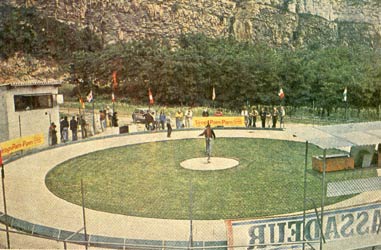 |
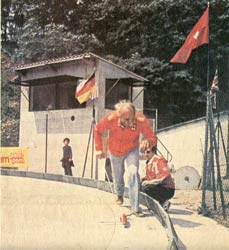 |
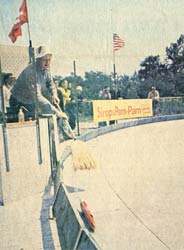 |
| Lyon, Couzon au Mont d'Or EM 1979 | George Fausch | Rossi possibly? |
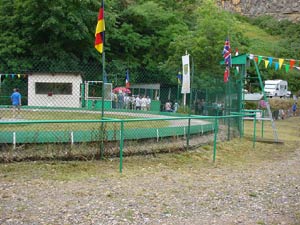 |
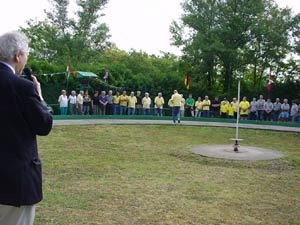 |
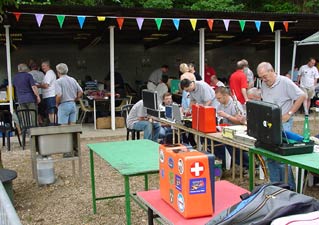 |
| Track in 2005 | Otto Stroebel opening the 2005 EC | Pit area |
The Lyon track at Couzon au Mont d'Or hosted the World Championship in 1995 and five European Championships from 1974 to 2005 until subsidence and vandalism caused it to close just a few years ago.
Dieppe
Perched on the cliff top overlooking the town of Dieppe, the track featured twin circles for the smaller and larger classes. Its position right beside a main road and with housing immediately opposite was hardly ideal, finally being closed around forty years ago. It hosted the European Championships in 1968, before horsing aprons came into use. The track remained until the car park it occupied was extended just a few years ago. Severe cliff falls are putting the nearby houses and site in peril, so a last series of photos before it was dug up.
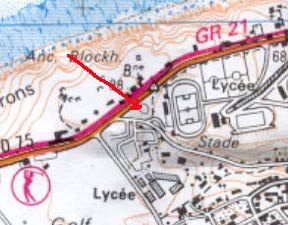 |
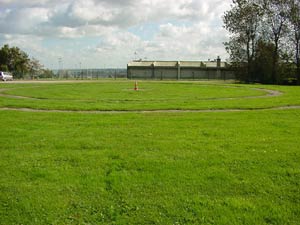 |
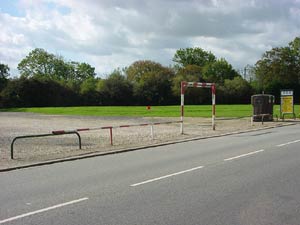 |
| Still on IGN map | School stadium in background | Car park and roadside location |
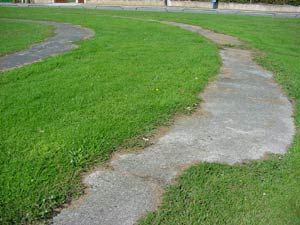 |
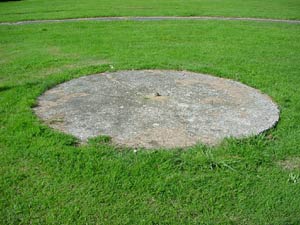 |
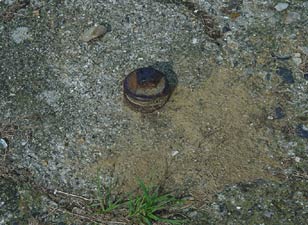 |
| Double track, no apron | Horsing circle | Pylon plug still in place |
|
Thanks to Phil Abott and his family we have this aerial photo of the track. To the left of the track is the Rue de Pourville before any houses were built along that stretch and in the foreground, the municipal campsite that was still in existence into the 90s, now a golf course. The cliff fall is now nearly back to the bend in the road. Update 2022: Recent cliff falls have now closed the road, which has been re-routed through the athletics stadium and the site of the track. Does anyone have any photos of action on the track please? |
|
For interest, the
winners at the EC in 68:
Class 1 V. Oerkeyni 165.440kph
Class 2 Lothar Runkehl 192.220kph
Class 3 Jozsef Peto 220.850kph
Class 4 Harald Arlautzki 240.320kph
Club de Modelisme de Cachan Paris
|
|
This photograph of Horst Denneler was the heading for a feature on tethered cars and the Paris track and roughly translated talks about a racing car going by at speed on the concrete track. We believe the horser (lancer) to be Manfred Pfefferle. Cachan hosted races until 1980, the last event being in April before the move to Lyon. The last winners at the track were Serge Holc, Manfred Pfefferle, Bernd Burk and Celestin Duran. OPS was already dominant in 5cc with Rossi still to the fore in 10cc, but OPS taking over again within months. The photos below were taken in October 1979 by the late Geoff Sheppard who travelled to the meeting with David Giles, European Champion and record holder in 5cc. David recalls that he won the class at this meeting. |
The track was in an area used by the council to store coaches and bin lorries and in a built up area as well. The two circles were to accommodate tethered cars on the inner and control line aircraft on the outer. The site also had a sports club with refreshment and toilet facilities. CMC is still functioning, primarily for team racing.
|
|
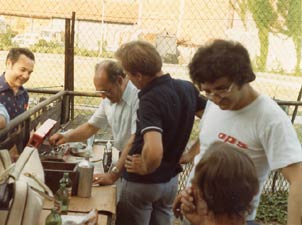 |
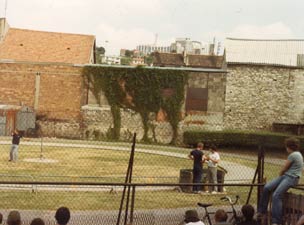 |
|
Michel Duran ready
with the broom Manfred Pfefferle horsing |
Celestin Duran
Michel Duran Manfred Pfefferle |
Minimal protection for those running cars |
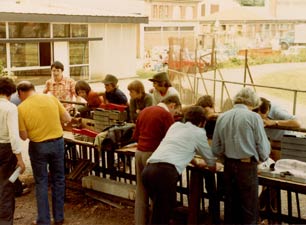 |
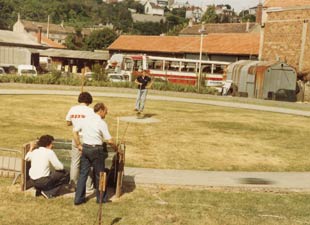 |
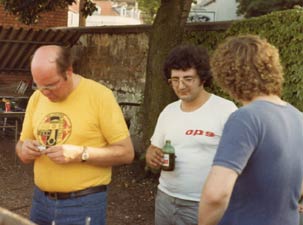 |
| Pit scene, Horst Denneler L, Serge Holc R | 213k 2.5cc 231k 5cc 265k 10cc | Horst Denneler, Michel Duran, David Giles |
Via the marvels of what's app and facebook have come these photos from Gerard Billon and Danielle Duran that hark back to events at this French track from the fifties and we are guessing the group photo is from one of the last meetings? We hope we have the name in the correct order?
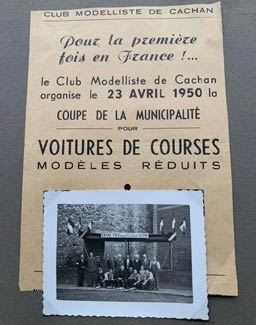 |
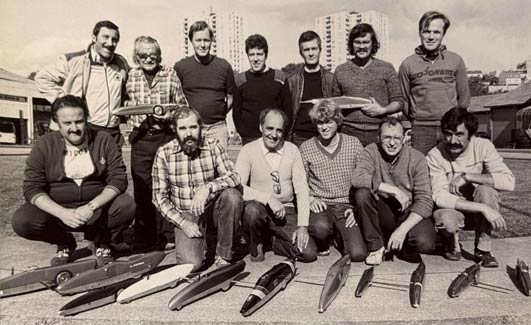 |
|
April 1950
poster and photo from
The Grand Prix Ville de Chachan |
Top Row:- Joseph Kraznai Jean Yves
Delacourt Philippe Caillaud |
SMCC Landikon Switzerland
The Swiss Model Car Club was founded on January 7th
1951 in Basel. Enthusiasts from Zurich and Bern
later created their own sections that joined FEMA.
With no track at that stage, races took place on
school playgrounds, car parks and in halls,
including the first ever European Championship in
1952 in Geneva. With permanent tracks already in
existence in many European countries, the SMCC was
in need of a track of their own that complied with
international regulations. In January 1952, the
Zurich section of the SMCC issued ‘an invitation to
the founding meeting’ that led to the building of a
track at Landikon near Birmensdorf, which is to the
south west of Zurich. The founder and person largely
responsible for establishing the track was Emil
Schlatter. Unlike most tracks that
start of on a relatively flat piece of land, the
site at Landikon was on a hillside that required
several thousand tons of soil to be moved to create
the circle, the spoil being used to create spectator
banking, pit areas etc. The full sized excavator
gives a clear indication of the size of this task.
As was often the case, there were two concentric
circles, one relatively small for 1.5 and 2.5cc cars
and a full sized circle for the larger cars. Another
notable feature was that the entire circle was paved
and carried advertising for Firestone tyres. The track opened in
1953, hosting the European Championship there with
competitors from Italy, Britain, France and Sweden,
as well as the host nation. Competitors from Britain
had a very close association with the track having
won the team trophy that year, with Jack Cook and
Jim Dean winning their first European Championships.
Both would be regular visitors for several years,
winning further international events there.
The track did
not host another European Championship until 1963 as
the opening of the Witterswill track at Basel in
1956 gave Switzerland a second venue. These venues
hosted a unique ‘double header’ in 1958 with the
inaugural World Tethered Car Championship at Zurich
and the European Championship at Basel on
consecutive weekends.
In 1972, the landlord
of the site at Landikon gave notice for the SMCC to
vacate the track, ostensibly so he could use it for
his own purposes, covering it in a thick layer of
earth. The track is still believed to exist under
the soil in the area shown with the red circle. With
the Zurich section of the SMCC unable to find a new
site they merged with the Basel section in 1977. We are most grateful to
Christoph
Zaugg, Roland Salomon, Philipp Meier and the Swiss
Model Car Club for photos and
information.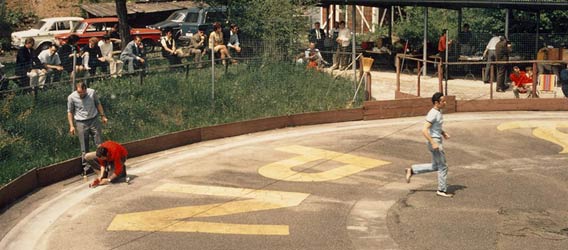
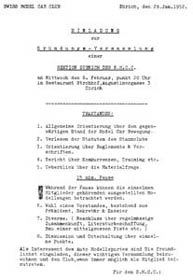
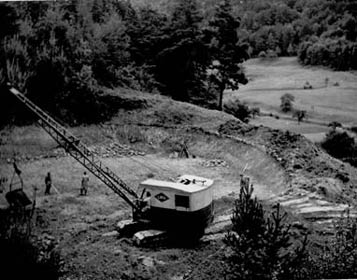
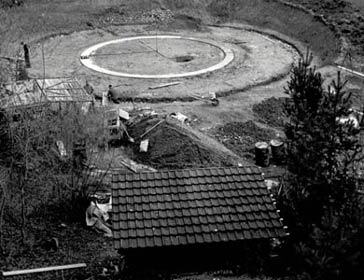
Inaugural meeting
Levelling the site
Inner
running surface
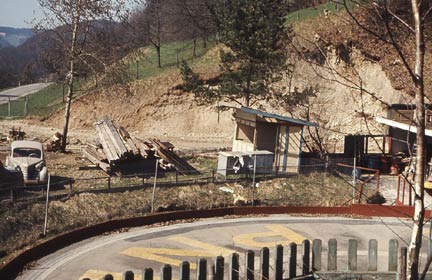
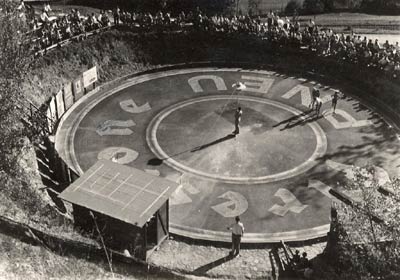
Pit
are showing amount of excavation
Amphitheatre created by the track and
banks
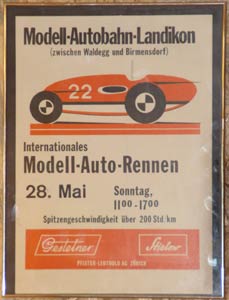
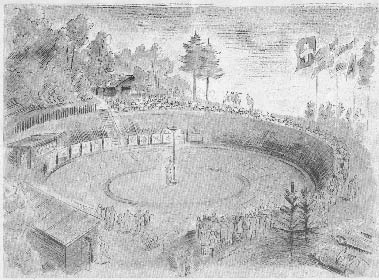
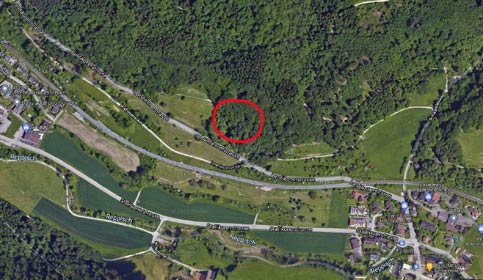
Landikon track 1953-1972
Track
location 47.354884, 8.456090 Circle can
still be seen
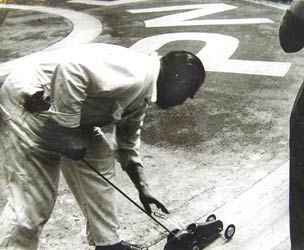
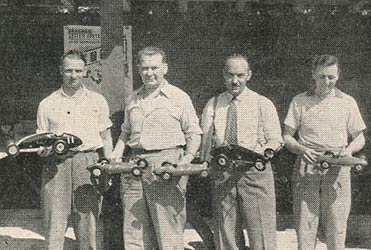
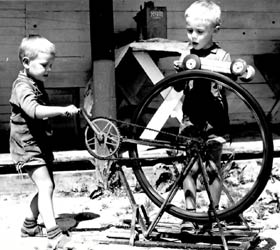
Jack
Cook 10cc Dooling
Cuttler, Cook, Dean, Petrie 1953
Two
young Swiss enthusiasts 1968
Sweden
GMRK
Göteborg Tracks
In his recent reminiscences, John Goodall recalls being taken to the site of the original Göteborg Club track at Save, which had by then had become the airport that he had flown in to and an impressive cold war museum, which he visited. This track, which hosted the 1971 European Championship, was situated at what had been a top secret Swedish air force base that included hangars blasted out of the bedrock, which house the museum. The base closed in the late 60s, and some ten years later became the second civil airport to serve the town. The tethered car track was opened in 1967 but needed resurfacing in 1978.
Sadly, just two years later, the building of the new Hisingsladen road to the Volvo factory in Törslanda resulted in the GMRK having to relocate to a new site and build an entirely new track and facilities. The last meeting at the Save track was on the third of June 1980. The runway at Save was extended in 1984 to accommodate larger aircraft but ironically, although Save became Göteborg City Airport and home to budget airlines from 2001, it was only able to operate as such for thirteen years before all scheduled flights were transferred to Landvetter as the larger aircraft were breaking up the taxiways.
|
The new track was built in the grounds of the Alelyckan waterworks in Largeholm, being completed in late 1984. A practice run was held in the Autumn of that year. The first official meeting was on the 24th-25th August 1985 with three drivers over 300kph, impressive for the time, Lennart Hellander topping the list at 307kph. The track was primarily used for Club and domestic events with the occasional FEMA GP or GS added to the calendar and was in use for less than two decades before another eviction.
The future of both the Göteborg tack and the one at
Gavle were both in doubt over the winter of 2004/5,
but happily, Gavle continues to operate
through to the present. Not so for the Larje Ring
though, as the city council served notice on the Göteborg Club that their lease would not be renewed
as the site that they had occupied for just
on twenty years years was required as a dump
for waste soil. |
|
|
|
There was a vestige of hope that the track could be retained, especially if activities could be extended to youth and adult training, but this proved not to be viable and so the Club eventually was forced to vacate in 2005. As the photos show, the site had already started to be filled with waste, prior to burying the track as at Landikon in Switzerland. The last sanctioned event was in June 2004 where the winners were Jan-Erik Falk 1.5cc, Priit Hoyer 2.5cc, Mart Sepp both 3.5cc classes, Tiit Luman 5cc and Gualtiero Picco 10cc. Left: 2003 |
The site of the track is now an area of woodland between the waterworks building and the Gamlestadsvagen but of the track, nothing can be discerned.
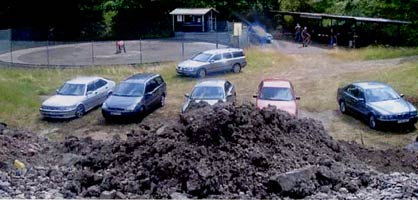 |
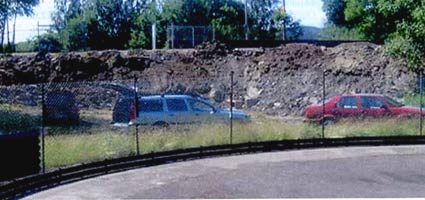 |
| The track from the top of the spoil | The spoil encroaching |
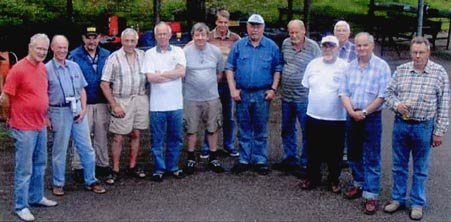
The final meeting was on July 2nd and 3rd 2005 where Mats Böhlin had the honour of making the last ever run at 322.754kph. Also running were Leif Persson, Ake Ekstrand, Leif Linden, Kjell-Erik Odelius, Helge Eriksson, Nils-Erik Palmen, Nils Björk, Karl-Arne Karlsson and Ulf Ek, assembled above.
Thanks to Kjell-Erik Odelius and Leif Linden, who have provided detailed information and dates. if anyone has any photos from Save that they are prepared to share, we would be most grateful.
AMCA Algiers
Although not strictly a European track, Algeria was a French colony for many years with a huge French population. The proliferation of French tracks continued to expand with a superb tethered car track at the Stade Jules Verne in Algiers. The connection with Jules Verne was reinforced with a large model of his famous 'Rocket to the Moon' adjacent to the track. The director of the Auto Modele Club Algerian and catalyst for the building of the track was Dr Chabelard who, for Pentecost in 1957 organised an International 'Automodelisme' Festival. As well as the tethered car event there would also be a huge exhibition of a variety of models in the 'Salon De La Marine'. Although there were a number of local members, to make it a truly International event would require more experienced competitors from European Countries. To accommodate this, a charter plane flew a group over, which included Swiss, German and French competitors, some of whom were European Champions.
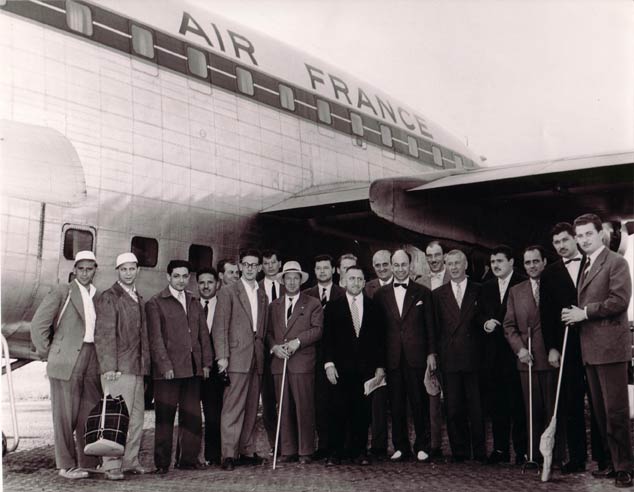
For interest, The entry list as far as we can
ascertain included
Switzerland. Roland Salomon, Philip Rochat, Fredi
Streun, Willi Jahlberg, Frans Berner, Eric
Hostettler
France.
Celestin Duran, J Durand, H Stephan, R Bouche,
Didier, with car and engine builder Msr Steeves
Italy
Miretti
Germany Lallinger,
Homrighausen, Eyers
Algeria
Chabelard, Blaise, Esposito, Acens
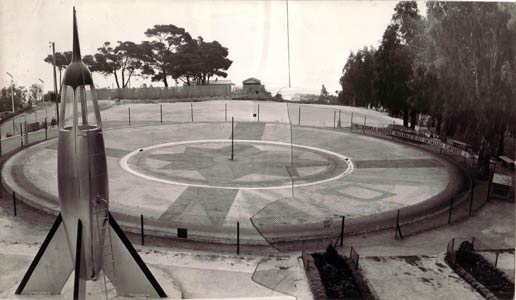 |
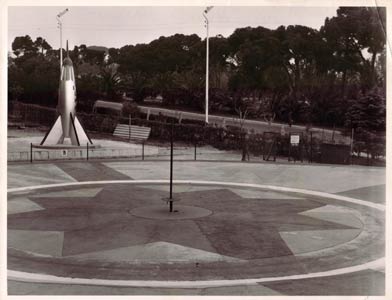 |
| Track at Stade Jules Verne overlooking Baie d'Algiers | |
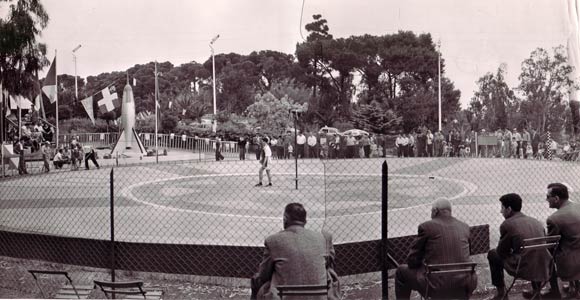
Possibly Roland Salomon horsing
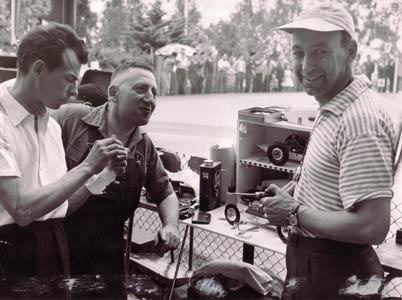 |
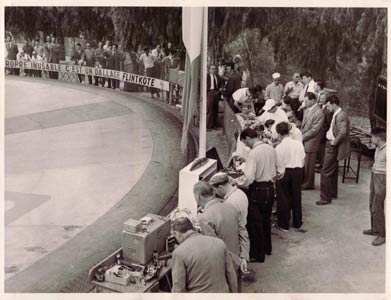 |
| Philip Rochat | Pit area |
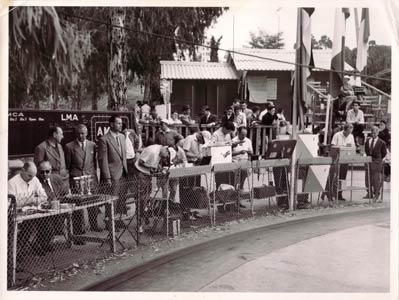 |
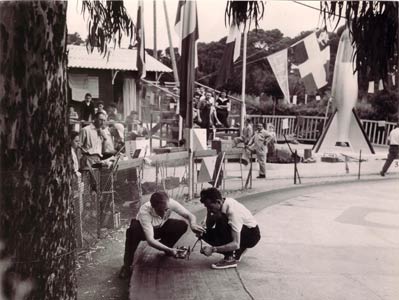 |
| Timekeeper Mr Calleja left | 5cc ZN car being readied |
1.5cc Salomon 119.2kph Miretti 105.2kph
2.5cc Salomon 123.2kph Salomon 120.00kph Lallinger 116.1kph Blaise 92.3kph Chabelard 90.00
5cc Miretti 151.2kph Berner 124.1kph Blaise 117.6kph Esposito 115.3kph
10cc Jalhlberg/Rochat 191.4kph Lallinger 183.6kph
Streun 178.2kph Stephan 174.7kph Hostettler 169.8kph
Chabelard 162.1kph
Dr Chabelard's speed was claimed as a new
French record for the 'experimental class'
In addition, the second day of competition was given over to an endurance contest lasting over three hours involving numerous stops for refuelling and restarts, which proved to be the Achilles heel of the more experienced competitors who found 'starting their fast cars difficult'. Esposito ran out the winner with 209 laps, only Durand and Bouche getting amongst the local competitors.
Thanks to Christian Schmutz for these photos
Eger Hungary
Not so much a 'long lost track' as a sadly neglected facility. The track was in regular use until 2004 having hosted two European Championships in 1990 and 1996. On both occasions Class 5 was won by Paul Otto Stroebel. Urs Bach won the third of his six titles there and Peter Arlautzki the first of his Class 2 titles. These photos were posted on the speedmodelcar facebook page where Urs commented 'Renovate and let's run again'.
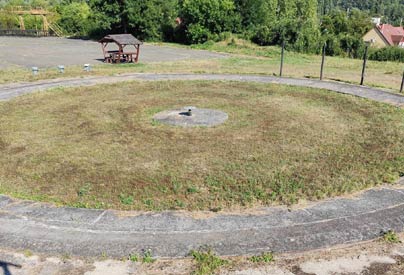
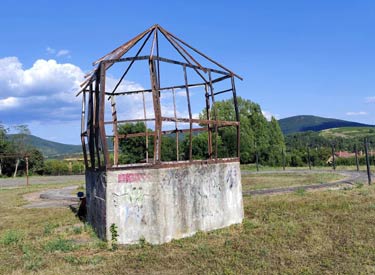 |
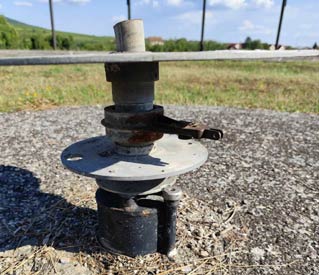 |
| Remains of the driver's refuge | Pylon and horsing platform still in existence |
Although there are still some posts for the safety fence, all traces of the Kickboards and supports have long gone.
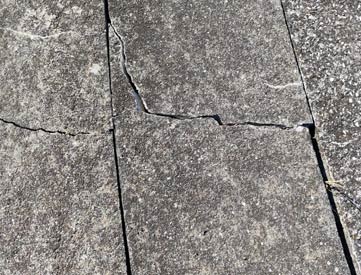 |
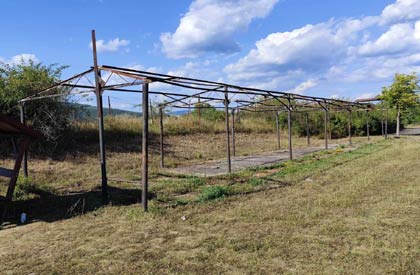 |
| Track deterioration | Remains of 'pit facilities' |
Kastrup Denmark
Just a little addition to your “Long Lost Tracks”. This is the track in Kastrup, just south of Copenhagen. It was built in 1948 and worked for several years, until it was abandoned in mid sixties. It was totally removed in 1975. Notice the advertisements for the Danish engine “CEROS” – there was also one for the “Viking” Jens Geschwendtner
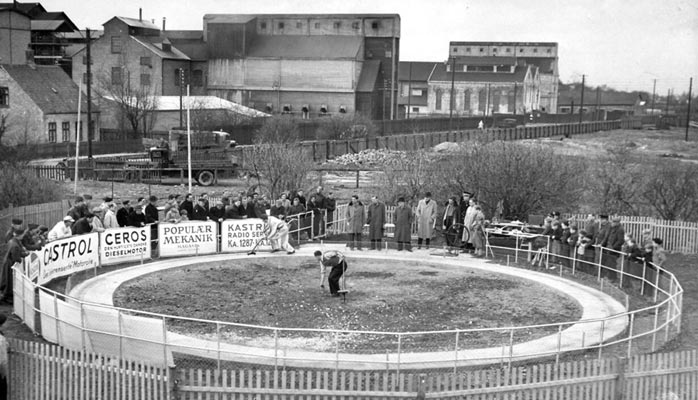
©copyrightOTW2024